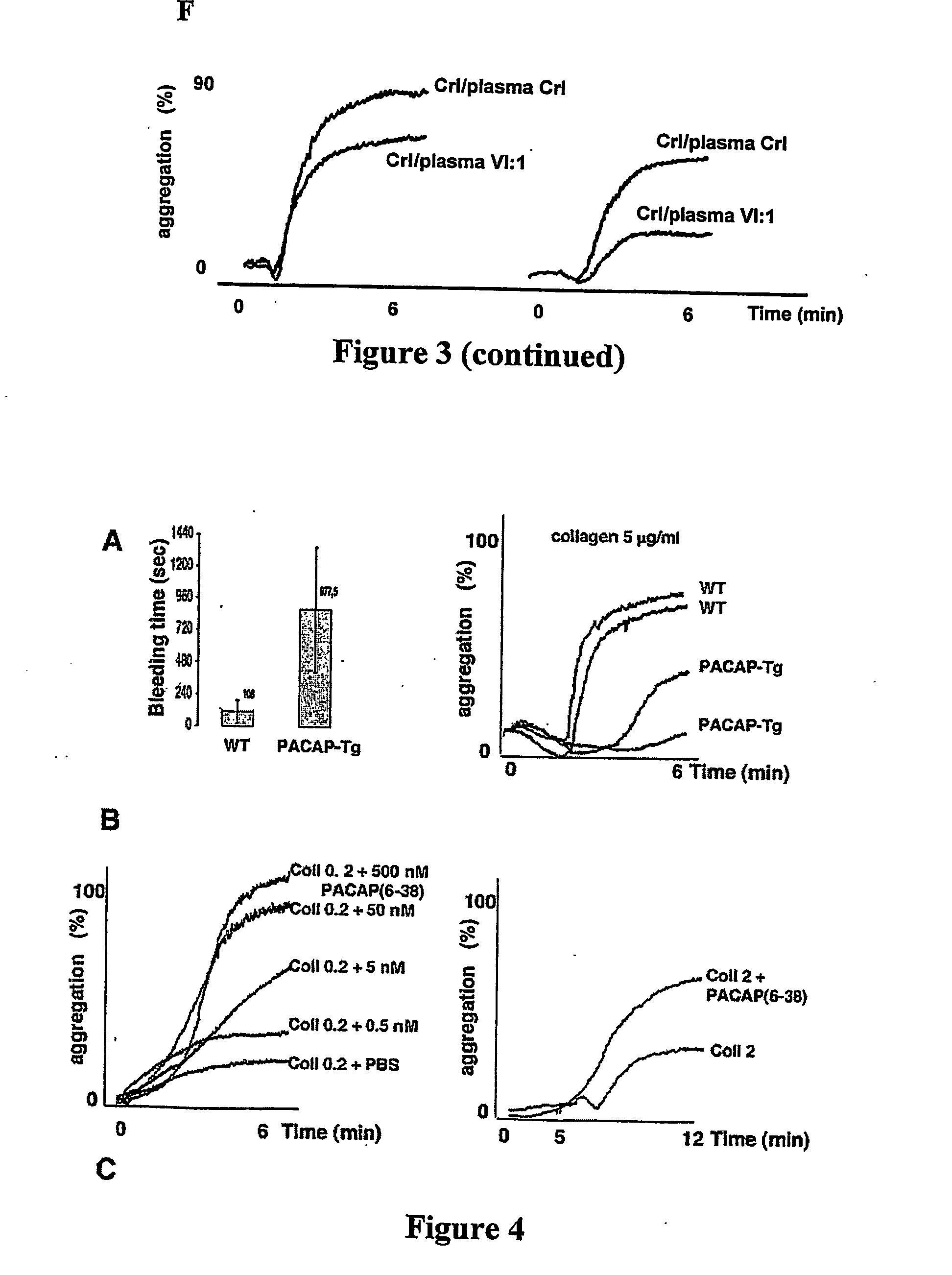Inhibition of pacap signalling for the prevention and treatment of thrombocytopenia
a technology of thrombocytopenia and signalling inhibition, which is applied in the field of inhibition of pacap signalling for the prevention and treatment of thrombocytopenia, can solve the problems of mild to even severe bleeding problems, compromise the patency of blood vessels, morbidity and mortality in developed countries, etc., and achieve the effect of preventing or treating thrombocytopenia and inhibiting the transcription or translation of pacap
- Summary
- Abstract
- Description
- Claims
- Application Information
AI Technical Summary
Benefits of technology
Problems solved by technology
Method used
Image
Examples
example 1
Generation of Megakaryocyte-Specific PACAP Overexpressing Mice
[0088] The murine GPIIb promoter (extending from +23 to 508 relative to the initiation start site) was excised from the mGPIIb-pGL3 plasmid by digestion with KpnI and BamHI and inserted into the KpnI-BamHI-digested PACAP-pcDNA3.1 vector (Invitrogen) in front of the mouse PACAP gene (Denarier et al. (1993), Biochem. Biophys. Res. Commun. 195:1360-1364). The mouse PACAP gene was amplified from brain cDNA with primers mPACAP1R 5′-GTAGCCGCTCGAGGATCTGCTACAAGTATGC-3′ [SEQ ID NO: 3] and mPACAP4F 5′-GTTAGCCGAATTCAGTTCMGGTCTGGCTAG-3′ [SEQ ID NO: 4], sequenced, and cloned into the EcoRI-XhoI site of the pcDNA3.1 vector. The 2.2-kilobase (kb) KpnIDraIII fragment (GPIIb-PACAP) was excised and purified for zygote injection. The GPIIb promoter has been successfully used to restrict transgene expression to the megakaryocytic cell lineage of mice (Tronick-Le Roux et al. (1995) J. Exp. Med. 181:2141-2151). Transgenic PACAP overexpressing...
example 2
PACAP Overexpression in Patients
A. Patient Descriptions
[0089]FIG. 1 represents a family characterised by an unbalanced segregation of the reciprocal translocation t(18;20) (p21;p13), of which different members suffer from unexplained mental retardation. The propositus (VI:1) is a 23-year-old boy with a hypogonadotropic hypogonadism and is followed for epilepsy, severe mental retardation, hyperactive behaviour and hypotonia. He has an increased bleeding tendency and the Ivy bleeding time was markedly prolonged (>15 minutes) but coagulation studies are normal. Electron microscopy of his platelets is completely normal but he presented on different occasions with a moderate thrombocytopenia, as his platelet count is always about 70-90×103 platelets / μl. His karyotype shows a partial trisomy 18p and monosomy 20p. His brother (VI:2), father (V:2) and maternal grandmother (IV:6) are phenotypically normal, have no bleeding problems and have a normal karyotype. In contrast, his mother (V:3...
example 3
Influence of PACAP in Platelet Aggregation by Studies in Mice
[0097] Functional platelet studies from patient VI:1 show that increased levels of PACAP(1-38) in plasma result in increased basal cAMP levels and a platelet hypofunction. The role of PACAP(1-38) in platelet function was also studied in mice by subcutaneous injection of polyclonal or monoclonal anti-PACAP antibodies.
[0098] FVB mice were injected three times subcutaneously with 200 mg of an anti-PACAP or a control anti-b2-glycoprotein I polyclonal antibody or four times with 50 mg of an anti-PACAP (PP1A4) or an anti-RGS2 monoclonal antibody with an interval of 3 days between injections. At day 14 after the first injection, whole blood from the inferior vena cava of mice anesthetized by intraperitoneal injection of 60 mg / kg sodium pentobarbital was drawn into 20 μg / mL hirudin. A platelet count was performed on the venous blood sample using the Cell Dyne 1300 (Abbott). Blood was centrifuged at 100 g for 10 min, allowing sep...
PUM
| Property | Measurement | Unit |
|---|---|---|
| concentrations | aaaaa | aaaaa |
| concentration | aaaaa | aaaaa |
| molecular weight | aaaaa | aaaaa |
Abstract
Description
Claims
Application Information
 Login to View More
Login to View More - R&D
- Intellectual Property
- Life Sciences
- Materials
- Tech Scout
- Unparalleled Data Quality
- Higher Quality Content
- 60% Fewer Hallucinations
Browse by: Latest US Patents, China's latest patents, Technical Efficacy Thesaurus, Application Domain, Technology Topic, Popular Technical Reports.
© 2025 PatSnap. All rights reserved.Legal|Privacy policy|Modern Slavery Act Transparency Statement|Sitemap|About US| Contact US: help@patsnap.com



